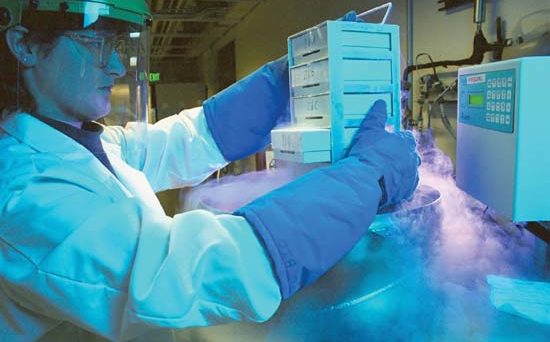
All life on earth begins with a single cell. During an organism’s development, cells divide and specialize to form complex tissues. However, how many distinct cell types exist is a matter of active discussion, which narrows down to the definition of a cell type in respect to more dynamic cell states. Recently, the capability to analyze individual cells using single-cell sequencing methods revolutionized the way we approach the complexity of tissues.
Uncoupling experiments from prior knowledge, we switch project designs from hypothesis to data-driven experiments, allowing a largely unbiased characterization of tissues of interest. In this regard, single-cell studies greatly contributed to our understanding of brain, blood or pancreas tissue composition and is likely to further deepen our knowledge about the biology of the human body in the near future.
While sequencing costs are decreasing constantly, there seems to be no limit to upscale the numbers of cells that are analyzed. Accordingly, recently published data sets include the RNA sequencing from 1.3 million brain cells or the 50-fold “shotgun cellular coverage” of all cells forming the nematode Caenorhabditis elegans. When costs for sequencing turn out to be minor, what presents the future bottle neck and could prevent us from sequencing every cell type forming the human body?
Although human cells are available at sufficient amount; it is the high quality required for single cell procedures that often hinders straightforward study designs.
Assuming that sequencing library preparation costs drop in the same speed as sequencing itself and that computing resources are capable of handling such quantity of data, it will be the biological material itself that challenges a high-throughput production pipeline towards a comprehensive cell atlas of the human body. Although human cells are available at sufficient amount; it is the high quality required for single cell procedures that often hinders straightforward study designs.
While high integrity of RNA molecules are sufficient for bulk transcriptome sequencing, single cell RNA analysis requires intact cells for efficient cell isolation and the generation of complex sequencing libraries. The analysis of nuclear RNA partially circumvents this issue, however, reduced starting material results in even sparser information per cell and it is unclear if nuclear RNA will be sufficient to deconvolute closely related cell types.
In our recent work published in Genome Biology we addressed the potential bottle neck of sample supply by evaluating the possibility of long-term sample storage without compromising the integrity of cell structures and RNA molecules. We were able to isolate intact single cells from cryopreserved cells and tissues, including blood, colon and tumor samples, and showed that gene expression profiles remained unaffected by the conservation method.
We were able to isolate intact single cells from cryopreserved cells and tissues … and showed that gene expression profiles remained unaffected by the conservation method.
We tested samples using full-length (Smart-seq2) and digital 3’-end counting methods (MARS-Seq) without detecting systematic biases introduced by the freezing procedure and storage at 80°C or in liquid nitrogen. This opens up new avenues for single cell studies as cryopreservation uncouples the time and location of sampling from subsequent cell separation and sequencing procedures.
We expect the method to impact two main areas that could greatly benefit from sample conservation. Firstly, sampling is facilitated in the clinical context at institutions without access to specialized equipment or outside of facilities’ working hours. For example, clinical samples can now be archived and patient cohorts can be prospectively collected for large-scale single cell genomics studies. Further, material can be sampled over the course of patient treatment allowing the analysis of dynamic changes. Secondly, samples from time-course experiments can be processed in a single batch, greatly reducing technical artifacts (batch effects), which could be the source of false-positive results. Moreover, samples can be stored and used as backup for failures or for technical replication.
We foresee that cryopreservation will greatly influence future single cell study designs. Importantly, it was shown to be compatible with different RNA sequencing strategies, allowing a straightforward implementation in standard operation procedures of large facilities and specialized research laboratories. We hence expect a paradigm shift in single cell research that broadens its scope while increasing the robustness of the results.
Dr. Holger Heyn
The mission of the group is the implementation of novel single cell genomics technologies and their application in a research and clinical context. Regular updates are published on Twitter.
Latest posts by Dr. Holger Heyn (see all)
- Broadening the scope of single cell sequencing technologies - 3rd March 2017
Comments